人教版七年级英语上册教案:unit5 SectionA(1a-1c)-2043613391
Unit5SectionA(1a-2d)教学设计2023-2024学年人教版英语七年级上册
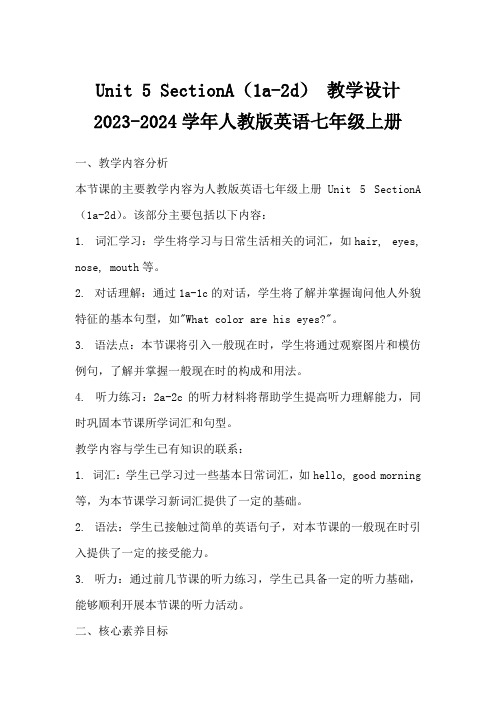
Unit 5 SectionA(1a-2d)教学设计2023-2024学年人教版英语七年级上册一、教学内容分析本节课的主要教学内容为人教版英语七年级上册Unit 5 SectionA (1a-2d)。
该部分主要包括以下内容:1. 词汇学习:学生将学习与日常生活相关的词汇,如hair, eyes, nose, mouth等。
2. 对话理解:通过1a-1c的对话,学生将了解并掌握询问他人外貌特征的基本句型,如"What color are his eyes?"。
3. 语法点:本节课将引入一般现在时,学生将通过观察图片和模仿例句,了解并掌握一般现在时的构成和用法。
4. 听力练习:2a-2c的听力材料将帮助学生提高听力理解能力,同时巩固本节课所学词汇和句型。
教学内容与学生已有知识的联系:1. 词汇:学生已学习过一些基本日常词汇,如hello, good morning 等,为本节课学习新词汇提供了一定的基础。
2. 语法:学生已接触过简单的英语句子,对本节课的一般现在时引入提供了一定的接受能力。
3. 听力:通过前几节课的听力练习,学生已具备一定的听力基础,能够顺利开展本节课的听力活动。
二、核心素养目标本节课旨在培养学生的英语学科核心素养,主要包括以下方面:1. 语言能力:通过本节课的学习,学生将能够准确地运用所学词汇和句型进行日常交流,提高英语口语表达能力和听力理解能力。
2. 文化意识:通过学习关于日常生活的词汇和对话,学生将了解西方文化中关于外貌描述的表达方式,增强对不同文化的认知和理解。
3. 思维品质:通过听力练习和小组讨论,学生将培养分析问题和解决问题的能力,提高逻辑思维和批判性思维能力。
4. 学习策略:学生将学会通过观察图片、模仿例句等方法来学习和掌握英语语法规则,提高自主学习和合作学习的能力。
三、重点难点及解决办法1. 重点:本节课的重点是让学生掌握与日常生活相关的词汇,如hair, eyes, nose, mouth等,并能够运用这些词汇描述他人的外貌特征。
人教版英语七年级上册Unit5SectionA1a1c优秀教学案例

1.培养学生对英语学习的兴趣和热情,使他们感受到学习英语的乐趣。
2.培养学生良好的学习习惯,使他们能够主动参与课堂,积极完成作业。
3.通过本节课的学习,使学生认识到学习英语的重要性,提高他们对英语学习的重视程度。
4.培养学生关爱他人、分享合作的精神,使他们能够主动帮助他人,与他人共同进步。
5.情感态度与价值观的培养:教师在教学过程中注重培养学生的情感态度与价值观,让学生认识到学习英语的重要性,培养学生对学校生活的热爱,使学生在学习过程中能够保持积极的态度,提高学习效果。
六、教学反思
在本节课的教学过程中,我作为教师注重创设情境、运用任务型教学法、设计多样化教学活动,以及注重评价学生的过程性表现。通过这些教学策略和手段,学生在课堂上表现出积极参与、乐于表达的态度,取得了一定的学习效果。
2.任务型教学法:教师运用任务型教学法,组织学生进行小组讨论和竞赛活动,让学生在实际操作中运用所学知识,提高学生的口语表达能力和团队协作能力。
3.多样化教学活动:教师设计了丰富多样的教学活动,如观察图片、讨论、角色扮演等,使学生在轻松愉快的氛围中学习英语,提高学生的学习兴趣和积极性。
4.过程性评价与终结性评价相结合:教师注重过程性评价与终结性评价相结合,通过观察学生的课堂表现、作业完成情况和小组合作情况,及时给予他们反馈和鼓励,提高学生的学习效果。
(四)反思与评价
1.学生自我评价:教师可以鼓励学生在课后进行自我反思,总结自己在课堂上的表现和学习成果。例如,让学生写一篇短文,描述自己在本节课中学到了哪些知识,以及如何在日常生活中运用所学知识。
2.同伴评价:教师可以组织学生进行同伴评价,让学生相互评价对方的学习成果和表现。例如,学生可以互相填写评价表,评价对方的口语表达、团队合作等方面。
人教版七年级英语上册教案 Unit 5 第1课时 Section A (1a-1c)
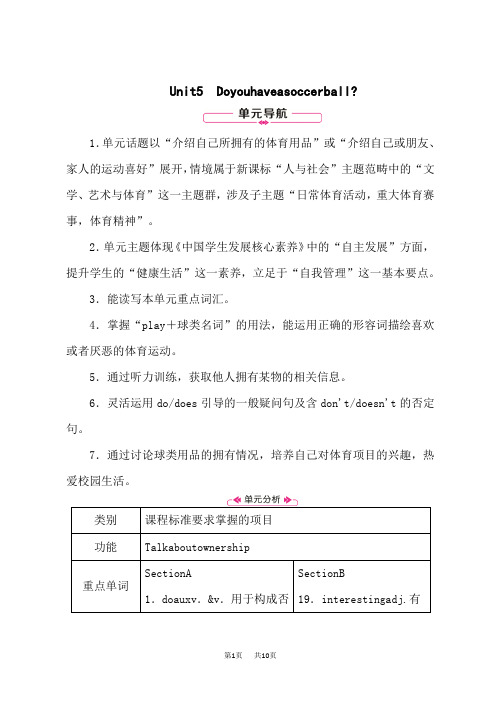
Unit5 Doyouhaveasoccerball?1.单元话题以“介绍自己所拥有的体育用品”或“介绍自己或朋友、家人的运动喜好”展开,情境属于新课标“人与社会”主题范畴中的“文学、艺术与体育”这一主题群,涉及子主题“日常体育活动,重大体育赛事,体育精神”。
2.单元主题体现《中国学生发展核心素养》中的“自主发展”方面,提升学生的“健康生活”这一素养,立足于“自我管理”这一基本要点。
3.能读写本单元重点词汇。
4.掌握“play+球类名词”的用法,能运用正确的形容词描绘喜欢或者厌恶的体育运动。
5.通过听力训练,获取他人拥有某物的相关信息。
6.灵活运用do/does 引导的一般疑问句及含don't/doesn't 的否定句。
7.通过讨论球类用品的拥有情况,培养自己对体育项目的兴趣,热爱校园生活。
续表【课时建议】本单元建议5课时SectionA(1a-1c)(一课时)SectionA(2a-2d)(一课时)SectionA(GrammarFocus-3c)(一课时)SectionB(1a-1d)(一课时)SectionB(2a-SelfCheck)(一课时)词汇短语:主要采用图片及多媒体展示助记法。
基本句子:采用多媒体展示及交际法(利用多媒体展示两人进行交际时的情景)。
语法:就本单元话题“The sporting goods they own”运用一般疑问句谈论物品所属关系,采用freetalk加深印象。
第一课时SectionA (1a-1c)Step1 情景导入【参考案例】T:Lookatthesportsthings.Here,thepingpongballismine.Itbel ongstome.SoIhaveapingpongball.“Have”isan importantverbinthisunit.Nowlistencarefully:Doyouhaveapingpongball?I'maskingyouifyouhaveapingpongball.Ifyouhave,say“Yes,Ido.”;ifnot,say“No,Idon't.”设计意图:通过提问引出本课的语言目标,在师生问答中自然而然导入新课。
人教版英语七年级上册Unit 5 Section A(1a-1c)教案

Unit5 Do you have a soccer ball?(SectionA1a~1c)Teaching Aims:nguage goals: words: do , have, bat, ping-pong, soccer, tennis, volleyball, basketballs entences : Do you have …? Yes, I do. I have a..No, I don’t. I don’t have…Does she\he have a…?Yes, she\he does. She\He has a…No, she\he doesn’t. She\He doesn’t have a…2. To let students know how to ask whether others have something or not and how to answer it.3. To develop the students’ ability of listening, speaking and reading. Important points:words: do, have, bat, ping-pong, soccer, tennis,volleyball, basketballs entences : Do you have …? Yes, I do. I have a..No, I don’t. I don’t have…Does she\he have a…?Yes, she\he does. She\He has a…No, she\he doesn’t. She\He doesn’t have a…Difficult points:s entences : Do you have …? Yes, I do. I have a..No, I don’t. I don’t have…Does she\he have a…?Yes, she\he does. She\He has a…No, she\he doesn’t. She\He doesn’t have a…Teaching aids:pictures , tape player and computerTeaching Procedure:Step 1: Warming-up1.greeting2. Free talkWhat’s this in English? It’s a key.How do you spell it ? K-E-Y.What color is it ? It’s yellow.Where is it ? It’s on the sofa.Step 2: Presentation1.Present new words (with pictures and PPT)What’s this?It’s a basketball (help students answer it)Let students read after teacher until they can read it fluently, then teach other new words like this.2.Teacher show a picture of a basketball and ask one student:T:I have a basketball. Do you have a basketball?S1:Yes,I do. I have a basketball(help students answer it)Teacher ask another student:T:I have a basketball. Do you have a basketball?S1:No,I don’t. I don’t have a basketball(help students answer it)3. Show the other pictures, have a practice of the target sentences.Step 3: Practice (group work ,Pair work )1.Boys ask and girls answer ,then girls ask and boys answer to practice the target language.2.Let students work in pairs ask and answering by using the target language(1c)3. Teacher show a picture of Cindy’s things and ask one student:T: Does she have a basketball?S1:Yes,she does. She has a basketball(help students answer it)Teacher ask another student:T: Does she have a volleyball?S1:No,she doesn’t. She doesn’t have a volleyball (help students answer it) 4. Teacher show a picture of Tom’s things and ask one student:T: Does he have a basketball?S1:Yes,he does. He has a basketball(help students answer it)Teacher ask another student:T: Does he have a volleyball?S1:No,he doesn’t.He doesn’t have a volleyball (help students answer it) 5. Let students work in pairs ask and answering by using the target languageStep 4 production1. Match the words with the things in 1a. Now focus your attention on theword list.2. The best listener Listen and circle the words you hear. (1b) You’re clever! Now please look at the four items in the list in 1b and read them. I’ll play the record twice. Please listen carefully and circle the words you hear.Step 5: Summarydo some little test to review what we have learned this class. HomeworkCopy the new words in your exercise-bookBlackboard design:Unit 5 Do you have a soccer ball?words: do , have, bat, ping-pong, soccer, tennis, volleyball, basketball sentences : Do you have …? Yes, I do. I have a …No, I don’t. I don’t have…。
人教版七年级英语(上册)Unit 5 Section A【1a-1c】 教案设计

Unit 5 Do you have a soccer ball?Section A 1a-1cTarget Language:1.Words:do, have, tennis ball, tennis racket, ping-pong ball,ping-pong bat, soccer ball, volleyball, basketball, baseball, baseball bat2.Key sentences:- Do you have a/an ...?- Yes, I do./No, I don’t.Learning ability goals:1.Say the names of different balls in English correctly.2 . Master how to know what balls others have by asking questions.3.Learn to talk about balls with friends in English.4.Master the usage of “have”.5. Improve their speaking, listening and writing abilities by finishing different tasks.Emotional goals:1. Learn to cooperate with their partners by finishing the tasks.2. Learn how to be more confident in class.3. Learn the importance of exercise after the class. Teaching aids:Multimedia, a blackboard and some cards Teaching important and difficult points:- Do you have a/an ...?- Yes, I do./No,I don’t.Teaching procedures:Step 1. GreetingGreet the students.Step 2. Warm-up1. Show a video to lead to the topic “sports”.2. Learn the new words about different kinds of balls.3. Play a game to remember the new words.4. Introduce Bob and help him to finish 1a.Step 3.Presentation and consolidation1. Show the new sentence patterns to students.2. Finish two tasks to make students master the newsentence pattern.Step 4. Listening1. Ask students to read the words together.2. Listen and check the answers.Step 5. Pair work1. Give an example conversation.2. Ask students to practice the sentence pattern.Step 6. Summary1.Words:do, have, tennis ball, tennis racket, ping-pong ball, ping-pong bat, soccer ball, volleyball, basketball,2.Sentence pattern:- Do you have a/an ...?- Yes, I do./No,I don’t.3. Know the importance of doing sports.Step 7. Homework1.Review what we learned today.2.Practice the sentence patterns with others to make friends.3.Make a survey about what you have and then make a report like this:Hello, my name is ...I have ...What about you?Blackboard designUnit 5 Do you have a soccer ball?Section A 1a-1ctennis ball tennis racket - Do you have a/an ...? baseball baseball bat - Yes, I do./No,I don’t. ping-pong ball ping-pong batsoccer ballvolleyballbasketball,。
Unit 5 Section A 1a 1c说课稿 人教版七年级上册英语

Unit 5 Do you have a soccer ball?Section A 1a-1cGood morning,dear judges! Today, it's my honor to be here to share my teaching ideas with all of you. My name is Bi Miaomiao. I come from Huhe Branch School.I will introduce my topic from eight parts: analysis of teaching material, analysis of students, learning objectives, teaching focus and difficulties, teaching and learning methods, teaching procedures, blackboard design and teaching reflection.Part 1 Analysis of teaching materialThe topic is taken from PEP, Go for it, the first book of Grade 7,Unit 5 Do you have a soccer ball? Section A 1a-1c.1a mainly deals with words. 1b is about listening. 1c is about speaking.It’s a listening and speaking lesson about sports and ownership. It’s interesting and practical. Students can use the new words and sentences to communicate with others in their daily life.Part 2 Analysis of studentsStudents of Grade Seven have learned English for many years and have some certain abilities of imagination, observation and creation. But they are short of vocabularies. Also, they have some difficulties in expressing themselves in English. However, they are interested in newthings and have a strong thirst for knowledge. In this lesson, students can learn new words about sports and structures about ownership, which can improve their language abilities.Part 3 Learning objectivesBased on the above analysis and the demands of new curriculum standard of 2022, there are four objectives.The first is language competence. Students can read new words such as soccer ball, volleyball and so on. They can also use the structure “Do you have a soccer ball? Yes, I do/No, I don’t” to talk about ownership.The second is learning competence. Students can understand the meaning of the target language and improve their listening and speaking skills. The third is thinking qualities. Students can use pictures, videos and objects to memorize words and expressions. The fourth is cultural awareness.They can know more about different cultures and learn to respect cultural diversity.Part 4 Teaching focus and difficultiesThe focus is to master words, phrases and sentences. The difficulties are to conduct the tasks step by step and use the target knowledge to make conversations.Part 5 Teaching and learning methodsThe teaching model is PWP. The teaching methods include situational teaching method, task-based language teaching method, audiolingual method and independent inquiry. Students can useco-operative and exploratory learning methods. In my opinion, teaching and learning are interactions.Part 6 Teaching proceduresStep 1 Lead in (3 minutes)I greet students and make a brief self-introduction as a P.E. and English teacher. I will give students some instructions to have a P.E. class. It can draw students’ attention, arouse their interests and lead into the topic.Step 2 Pr-listening (8 minutes)It mainly deals with words. I use pictures, videos and games . Then ask students to finish 1a and check the answers. This step can help students learn the target words and phrases. It can also reduce the difficulties for the following steps.Step 3 While-listening (4 minutes)Step 3 is about listening. Two tasks are designed to help train students’ listening skills and let students get familiar with the target sentences.Step 4 Post-listening (15 minutes)Let students practice the conversation in 1c to develop their abilities of speaking. Make their own conversations in pairs. I invite several pairs to perform to increase their awareness of cooperation. What’s more, achant and some exercises can help them strengthen what they learned in this lesson. Practice makes perfect.Step 5 Summary (4 minutes)I make a summary to rethink what they have learned in this class. And I will give value guidance to lead students to have a healthy life. Step 6 Homework (1 minute)There are two kinds of homework: required and optional homework. Students’ ability of learning and using English will be improved. They will get more practice and review after class.Part 7 Blackboard designU5 Do you have a soccer ball?Section A (1a-1c)By looking at the blackboard, it’s helpful for students to get the main content of this lesson clearly.Part 8 Teaching reflectionAfter this class, I will make reflections to promote better teaching and learning.。
《Unit 5 Section A 1a-1c》教案人教版英语七年级上册

Step 8
Homework
(PPT39)
1.Write down all the sports things you have.
2. Do an interview to ask your classmates:“Do you have...?”.
写单词、采访是为了帮助学生巩固本课新学的单词和句型。
板书设计
Unit 5 Do you have a soccer ball?
Section A (1a-1c)
tennis ball
ping-pong bat
soccer ball
volleyball
basketball
baseball bat
-Do you have a ping-pong bat?
通过Do you have…?导入,在轻松的氛围中学习新单词。看图片阅读这些单词、练习句型。通过讨论为本课的学习掀开了序幕,使学生了解本节课的新话题。
Step 2
Presentation
(PPT 15-24)
Work on 1a.
1. Ask Ss to read the words in 1a and then match the words with the things in the picture.
教 案
教学基本信息
学科
English
学段
初中
年级
七年级
单元
Unit 5
课题
Do you have a soccer ball?
总课时数
6
课时
Section A (1a-1c)
课型
人教新目标英语七年级(上册)Unit 5 Section A(1a--1c) 教案

Unit5 Do you have a soccer ball?(Section A 1a~1c)Analysis of the Teaching MaterialThis lesson is the first period of Unit5 in Grade sevenⅠ. After learning Unit 3 Is this your pencil?,students have learned how to identify ownership. On the basis of it ,students will learn to identify ownership further by using have. Students will learn some words on sports and some descriptive words.Analysis of the StudentsStudents in Grade 7 are more interested in learning English. They can cooperate the teacher well .They are willing to take part in the class activity.What’s more ,the topic sports is close to their lives.Teaching Methods:The Audio-lingual ApproachThe Communicative ApproachThe Task-based methodTeaching Aims:1.Enable students to read and use the words: have, soccer ball, tennis ball,ping-pong ball, volleyball, basketball, bat... and the sentences: Do you have …? Yes, I do. I have…No, I don’t. I don’t have…2. To make the students know how to ask whether others have something or not and how to answer it.3. To develop the students’ ability of listening, speaking and reading. And make the students love sports, love life.Key points: kinds of sports,Do you have …? Yes, I do. I have…/ No, I don’t. I don’t have…Difficult points: As above .Teaching aids: PPTTeaching Procedure:Step 1:Lead-inPlay a video named Do you have a pet to draw students’ attention.(歌曲导入,创设英语学习氛围,同时也为句型Do you have。
人教版英语七年级上册 Unit 5 Section A【1a~~1c】 教案设计

知识点
编号
学习目
标层次
检 测 题的 内容
1
理解
填空:Do you()a ping-pong ball?—Yes, I()。—Do you()a computer??—No, I()。
2
掌握
翻译以下句子:你有乒乓球吗?是的,我有。你有电脑吗?—不,我没有。
3
运用
Do you have a baseball? (否定回答) No, I don’t
4
掌握
I have a tennis racket. (改一般疑问句)
5
掌握
Do you play sports every day? (肯定回答) Yes ,I do.
形成性评价
通过本节课的学习,充分体现学以致用的教学原则。学生已从死背语法知识,机械模仿句型为主的方式过度为“做中学”的活用活学阶段。学生的学习积极性大大提高了。课堂气氛也更活跃。学生对学习英语的兴趣也大大浓烈了。
感谢、其他
感谢老师们对这篇教学设计的指导与帮助,同时也非常感谢评审团专家对我的指点和支持。
通过师生互动,生生互动进行操练来掌握
课前对学生的要求
学生先预习好单词,试着自己拼读单词。思考一个问题:我们体育课时用到哪些体育用品?并把不懂的单词与句子标出来。
教学媒体(资源)选择
知识点
编号
学习目
标层次
媒体
类型
媒体内容要点
教学
作用
使用
方式
所得结论
占用
时间Leabharlann 媒体来源1欣赏
动画播放
A new song
欣赏审美,陶冶情操
分片进行演示:I have a footba11.Do I have a football?自己回答:Yes,I d0.再问:Do I have a basketball?自己回答:No,I don’t.再使用其它物体和图片询问学生:Do I have…?
人教版七年级上册英语Unit 5 Section A (1a~1c)说课稿

Good morning, everyone! my name is Li Ruimin, I’m from Xi Ma middle school. It is my great honor to be here to share my teaching design with you. I’d like to begin thispresentation with seven parts. Now let me present them one by one.Part1 The Analysis of Teaching MaterialThis lesson is from section A(1a-1c) of unit 5 in Grade seven,It is mainly talking about ownership.The topic of this unit is spending time with friends. It is related to our daily life,so it is important to study them.Part 2The Analysis ofTeaching ObjectivesAccording to the new curriculumstandard, I think the teaching aims are the followings:First, the language ability is to grasp some important vocabularies such as tennis , ping-pong, bat,soccer, ball and so on. And the important sentence such as “Do you have a ping-pong bat? Yes, I do/No, I don’t.Second, the culture awareness is to help students express their opinions about doing activities correctly.Third, the quality of thinking is to improve students’ awareness of loving sports and loving themselves.Part 3 Teaching Key Point and Difficult PointAccording to the analyses above,Iset the key point is the usage ofkey words. The d ifficult pointis how to develop students’ listening and speaking skills..Part4 The Analysis of StudentsThe students in Grade seven have got some basic English, they are eager to learn, eager to show. But some of them have no enough bravery to speak English.. So it is important for the teacher to help them open their mouth to speak English.Part 5 Teaching MethodsBased on the content, I mainly adopt different teaching methods. For example,communicative teaching method,Task-based teaching method and cooperative learning approach. At the same time, I encourage students to finish the task actively. Give the class to the students and let them feel they are the masters of the class.Part 6 Teaching ProceduresIn this part, I have seven steps to say.Step1.Lead--inAt the beginning of the class, I show a video to the students. Beforewatching it, I ask a question “How many kinds of sports are there in the video?” The Purpose of my designis to lead in the topic and catch students' attention about the topic.Step 2. PresentationFirst, I show some pictures on the flash, ask students to read the newwords for several times. Then do a game “quick eyes”and a match to consolidate these words. Next, ask the students to finish the exercises in 1a. After checking the answers, let them read the dialogue on the picture. Finally ask the students to make their own dialogues and act them out. The purpose is to help students to grasp important words and the basic sentence.Step 3. ListeningLet the students listen carefully and circle the words they hear, then check the answer. Next , read the dialogue in 1c together. Pay attention to pronunciation and intonation. It aims to improve the students’listening and reading abilities .Step 4. PracticeIn order to consolidate the key words and the important sentence, the teacher design three activities.First, show some pictures and the sentence structure on the flash, according to the information, let some students ask questions,the others answer .Then, do Pair work. When the students are ready, let some of them show their dialogues in front of the class. Claps will be rewarded to good performers.Step 5. SummarySummarize the key words and the important sentence , let the students read again. Later let them know the benefit of sports. Thepurpose is to improve these teenagers’ awareness of loving sports.Step 6. HomeworkLet the students write some sports things they have . It helps them grasp the content better.Step 7. Black designUnit 5 Do you have a soccer ball?.—Do you have a ping-pong bat?---Yes, I do.---Do you have a ping-pong ball?--- No, I don’t.Part 7 Teaching ReflectionsIn my opinion, it is successful. My reasons are as follows:Firstly, the teaching objectives are quite clear. All the activities are focused on the theme.Secondly, the teacher promotes students’motivation and arouse students’ interestto learn English.That’s all! Thanks for your listening.。
人教版英语七年级上册Unit5SectionA1a1c说课稿

在教学过程中,我预见到以下可能的问题或挑战:
1.部分学生对一般现在时态的掌握不够熟练,容易混淆;
2.学生在口语练习时可能出现紧张、胆怯等情况;
3.课堂时间分配不合理,可能导致教学进度受到影响。
应对策略:
1.针对时态混淆问题,通过对比、举例等方式,帮助学生明确区别;
2.鼓励学生大胆开口,创设轻松的口语练习氛围;
(二)媒体资源
我将使用以下教具、多媒体资源和技术工具来辅助教学:
1.教具:实物、图片、卡片等,用于直观展示家庭成员和物品,激发学生的兴趣和注意力。
2.多媒体资源:PPT、视频、音频等,通过展示生动有趣的场景和对话,提高学生的听说能力,增强课堂氛围。
3.技术工具:电子白板、教学互动平台等,实现课堂实时互动,方便学生参与讨论、展示和反馈。
3.教师反馈:针对学生的表现,给予积极的评价和鼓励,同时指出需要改进的地方,并提供具体的建议。
(五)作业布置
课后作业布置如下:
1.复习本节课所学的家庭成员词汇和句型,确保掌握。
2.完成课后练习题,巩固所学知识。
3.家长协助孩子用英语介绍自己的家庭成员,录制视频,上传至教学互动平台,以便教师了解学生的实际应用情况。
2.口语练习:组织学生进行角色扮演,模拟真实场景进行对话练习,提高口语表达能力。
3.课后作业:设计一些练习题,如填空、选择、句型转换等,让学生在课后巩固所学知识。
(四)总结反馈
在总结反馈阶段,我将采取以下措施:
1.引导学生自我评价:让学生回顾本节课所学内容,反思自己的学习过程,总结收获和不足。
2.同伴评价:组织学生相互评价,提出改进建议,促进共同进步。
1.教学重点:
(1)家庭成员词汇的掌握;
Unit5SectionA(1a–1c)教学设计人教版七年级英语上册
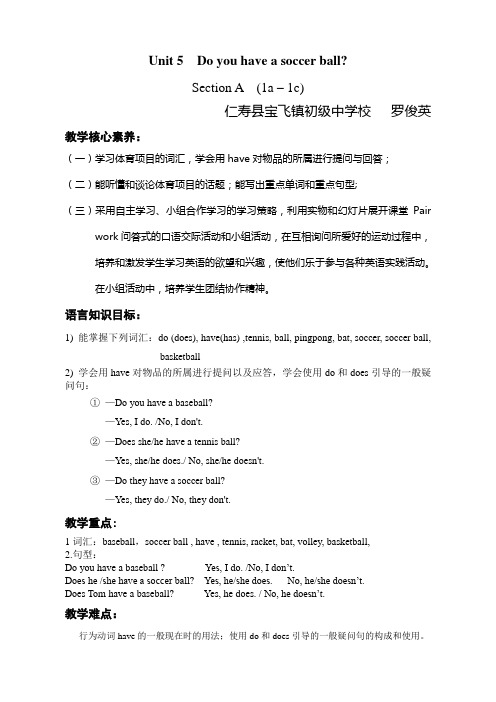
Unit 5 Do you have a soccer ball?Section A (1a – 1c)仁寿县宝飞镇初级中学校罗俊英教学核心素养:(一)学习体育项目的词汇,学会用have对物品的所属进行提问与回答;(二)能听懂和谈论体育项目的话题;能写出重点单词和重点句型;(三)采用自主学习、小组合作学习的学习策略,利用实物和幻灯片展开课堂Pair work问答式的口语交际活动和小组活动,在互相询问所爱好的运动过程中,培养和激发学生学习英语的欲望和兴趣,使他们乐于参与各种英语实践活动。
在小组活动中,培养学生团结协作精神。
语言知识目标:1) 能掌握下列词汇:do (does), have(has) ,tennis, ball, pingpong, bat, soccer, soccer ball,basketball2) 学会用have对物品的所属进行提问以及应答,学会使用do和does引导的一般疑问句:①—Do you have a baseball?—Yes, I do. /No, I don't.②—Does she/he have a tennis ball?—Yes, she/he does./ No, she/he doesn't.③—Do they have a soccer ball?—Yes, they do./ No, they don't.教学重点:1词汇:baseball,soccer ball , have , tennis, racket, bat, volley, basketball,2.句型:Do you have a baseball ? Yes, I do. /No, I don’t.Does he /she have a soccer ball? Yes, he/she does. No, he/she doesn’t.Does Tom have a baseball? Yes, he does. / No, he doesn’t.教学难点:行为动词have的一般现在时的用法;使用do和does引导的一般疑问句的构成和使用。
人教新目标英语七年级上Unit 5 SectionA 1a-1c教学设计

-----Yes, I do.
get the emotional aim of this lesson.
-----Why do you like playing ping-pong
ball?
-----Because it’s funny.
Step7. Homework:
To review what Ss learn and share it with
1. Recite the v来自cabulary/others.
2. Finish the PA20 on exercise
book. Blackboard Design:
Do you have a soccer ball?
Basketball Soccer ball football volleyball
1. To lead into today`s topic.
1. Sing an English song about “sports〞. 2. To review some key expressions.
2. Greet with students and ask some
questions about them.
ownership and interests towards sports.
--Do you have a ping–pong ball?
---Yes, I do. I have a ping-pong ball.
----Do you like playing ping-pong ball? To practice their speaking skills and to
2. Do-and -guess game of balls or bats. words.
人教版七年级上册英语Unit5SectionA1a—1c教学设计

3.各小组展示成果,其他同学认真倾听,教师适时给予评价和鼓励。
(四)课堂练习
1.教师呈现Unit5 Section A 1b的练习,要求学生根据图片,用there be句型完成句子。
2.学生独立完成练习,教师个别辅导。
3.学生互相交换答案,讨论并纠正错误。
人教版七年级上册英语Unit5SectionA1a—1c教学设计
一、教学目标
(一)知识与技能
在本章节的教学中,学生将通过学习人教版七年级上册英语Unit5 Section A 1a—1c的内容,掌握以下知识与技能:
1.词汇:学生能够掌握并熟练运用以下词汇:mirror(镜子),bedroom(卧室),kitchen(厨房),bathroom(浴室),living room(客厅),where(在哪里),put(放置),trash can(垃圾桶)。
2.难点:
(1)正确使用there be句型描述房间物品的位置,注意主谓一致和词序。
(2)熟练运用新词汇,如mirror(镜子),bedroom(卧室)等,进行情景对话。
(3)提高学生的口语表达能力,使其能在真实场景中灵活运用所学知识。
(二)教学设想
针对教学重难点,特提出以下教学设想:
1.创设情境,激发兴趣
5.评价方式多样化
结合形成性评价和终结性评价,关注学生在学习过程中的表现。鼓励学生自我评价和同伴评价,培养学生的自主学习能力。
6.融入情感教育
在教学过程中,注重培养学生的合作精神、环保意识和诚信品质。通过讨论家庭、生活环境等话题,引导学生热爱生活,关爱家人。
7.家校合作
加强与家长的沟通,了解学生在家的学习情况,共同促进学生的全面发展。
Unit5 (SectionA 1a-1c)教案 人教版七年级英语上册
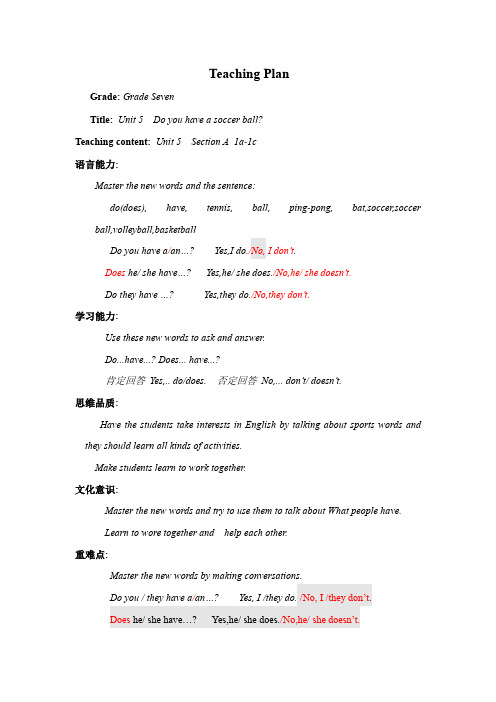
Teaching PlanGrade: Grade SevenTitle:Unit 5 Do you have a soccer ball?Teaching content:Unit 5 Section A1a-1c语言能力:Master the new words and the sentence:do(does), have, tennis, ball, ping-pong, bat,soccer,soccer ball,volleyball,basketballDo you have a/an…? Yes,I do./No, I don’t.Does he/ she have…? Yes,he/ she does./No,he/ she doesn’t.Do they have …? Yes,they do./No,they don’t.学习能力:Use these new words to ask and answer.Do...have...? Does... have...?肯定回答Yes,.. do/does. 否定回答No,... don’t/ doesn’t.思维品质:Have the students take interests in English by talking about sports words and they should learn all kinds of activities.Make students learn to work together.文化意识:Master the new words and try to use them to talk about What people have.Learn to wore together and help each other.重难点:Master the new words by making conversations.Do you / they have a/an…? Yes, I /they do./No, I /they don’t.Does he/ she have…? Yes,he/ she does./No,he/ she doesn’t.Pay attention to does. 教学用具:Computer and overhead projector 教学策略:Task-Based Language Teaching Teaching process:。
初中英语七年级上册人教新目标UNIT5SECTIONA(1A1C)教案
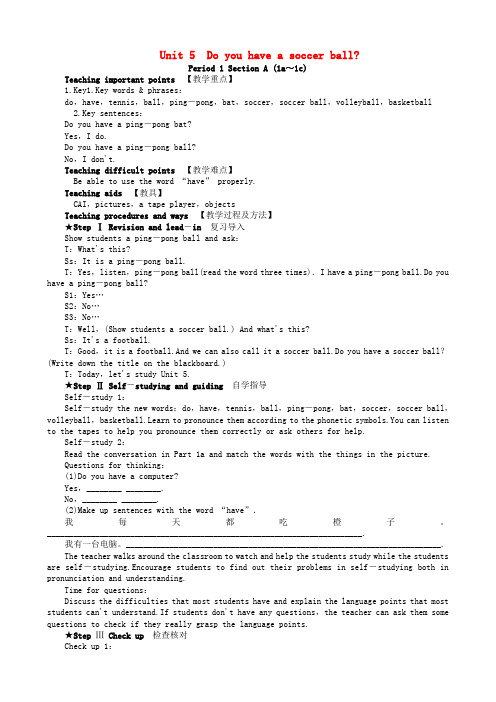
Unit 5 Do you have a soccer ball?Period 1 Section A (1a~1c)Teaching important points【教学重点】1.Key1.Key words & phrases:do,have,tennis,ball,ping-pong,bat,soccer,soccer ball,volleyball,basketball2.Key sentences:Do you have a ping-pong bat?Yes,I do.Do you have a ping-pong ball?No,I don't.Teaching difficult points【教学难点】Be able to use the word “have” properly.Teaching aids【教具】CAI,pictures,a tape player,objectsTeaching procedures and ways【教学过程及方法】★Step Ⅰ Revision and lead-in复习导入Show students a ping-pong ball and ask:T:What's this?Ss:It is a ping-pong ball.T:Yes,listen,ping-pong ball(read the word three times).I have a ping-pong ball.Do you have a ping-pong ball?S1:Yes…S2:No…S3:No…T:Well,(Show students a soccer ball.) And what's this?Ss:It's a football.T:Good,it is a football.And we can also call it a soccer ball.Do you have a soccer ball?(Write down the title on the blackboard.)T:Today,let's study Unit 5.★Step Ⅱ Self-studying and guiding自学指导Self-study 1:Self-study the new words:do,have,tennis,ball,ping-pong,bat,soccer,soccer ball,volleyball,basketball.Learn to pronounce them according to the phonetic symbols.You can listen to the tapes to help you pronounce them correctly or ask others for help.Self-study 2:Read the conversation in Part 1a and match the words with the things in the picture.Questions for thinking:(1)Do you have a computer?Yes,________ ________.No,________ ________.(2)Make up sentences with the word “have”.我每天都吃橙子。
人教版七年级英语上册Unit5SectionA1a1c教学设计

(二)教学设想
1.创设生活情境:通过展示学生熟悉的日常生活场景,引导学生用英语进行交流,激发学生的学习兴趣。例如,教师可以展示一张早晨起床、吃早餐、上学等场景的图片,让学生用所学词汇和句型进行描述。
(三)学生小组讨论
1.教师将学生分成小组,每组根据所学词汇和句型,结合自己的日常生活,讨论并制定一天的时间表。
2.学生在小组内部分工合作,互相提醒、纠正错误,共同完成时间表的制定。
3.各小组向全班展示自己的时间表,并用英语进行介绍,其他学生认真倾听,学习借鉴。
4.教师针对各小组的表现给予评价,鼓励学生积极参与小组讨论,提高合作意识和口语表达能力。
4.学生心理特点:七年级学生自尊心强,渴望得到肯定和表扬。教师在教学过程中应多给予鼓励和认可,增强学生的自信心,激发学生的学习动力。
三、教学重难点和教学设想
(一)教学重难点
1.重点:本节课的重点在于让学生掌握描述日常活动的词汇和句型,如morning, afternoon, evening, time, eat, drink, play, read, study, watch TV等,以及句型What time is it? It's ... o'clock. What do you do at ... o'clock? I ... at ... o'clock.同时,要让学生学会运用一般现在时描述自己的日常活动。
2.教师通过多媒体展示一组日常生活场景的图片,如早晨起床、吃早餐、上学、上课、午餐、课外活动、晚餐、做作业、看电视、睡觉等,让学生观察并描述图片内容。
人教版七年级英语上册Unit5SectionA(1a–1c)教学设计
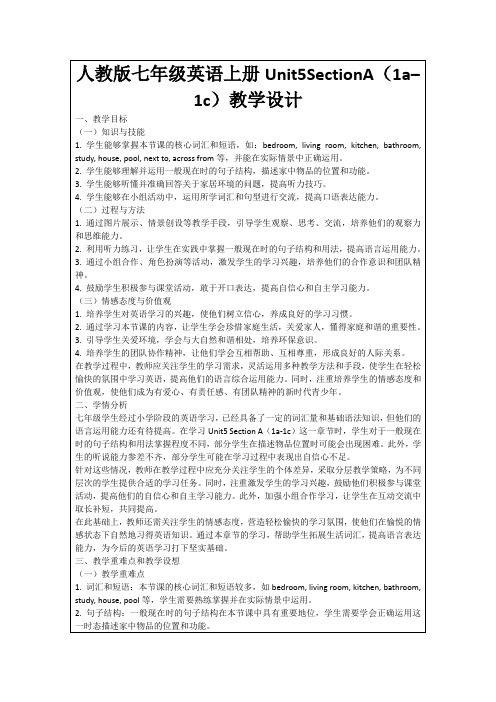
6.词汇复习:复习本节课学习的词汇和短语,确保熟练掌握,为下一节课的学习做好准备。
作业要求:
1.学生需认真完成作业,注意书写的规范性和准确性。
2.家长或同学协助完成角色扮演和口语练习,鼓励学生积极参与,提高自信心。
3.作业完成后,及时上交,教师将给予评价和反馈,帮助学生查漏补缺。
2.学生能够理解并运用一般现在时的句子结构,描述家中物品的位置和功能。
3.学生能够听懂并准确回答关于家居环境的问题,提高听力技巧。
4.学生能够在小组活动中,运用所学词汇和句型进行交流,提高口语表达能力。
(二)过程与方法
1.通过图片展示、情景创设等教学手段,引导学生观察、思考、交流,培养他们的观察力和思维能力。
3.小组代表汇报讨论成果,其他组成员倾听并给予评价。
4.教师巡回指导,解答学生疑问,鼓励学生积极参与讨论。
(四)课堂练习
1.教师设计一系列关于家庭环境的听力练习,让学生在听的过程中捕捉关键信息,提高听力技巧。
2.学生完成练习后,教师及时给予反馈,针对共性问题进行讲解。
3.教师设计口语练习,如角色扮演、小组讨论等,让学生在实际操作中运用所学知识。
2.通过学习本节课的内容,让学生学会珍惜家庭生活,关爱家人,懂得家庭和谐的重要性。
3.引导学生关爱环境,学会与大自然和谐相处,培养环保意识。
4.培养学生的团队协作精神,让他们学会互相帮助、互相尊重,形成良好的人际关系。
在教学过程中,教师应关注学生的学习需求,灵活运用多种教学方法和手段,使学生在轻松愉快的氛围中学习英语,提高他们的语言综合运用能力。同时,注重培养学生的情感态度和价值观,使他们成为有爱心、有责任感、有团队精神的新时代青少年。
人教版七年级英语上册Unit5SectionA1a1c说课稿

为了帮助学生巩固所学知识并提升应用能力,我计划设计以下巩固练习和实践活动:
1.小组讨论:让学生分组,讨论他们自己的宠物或喜欢的事物,用一般现在时态和情态动词can进行描述。
2.角色扮演:让学生分组,扮演故事中的角色,进行对话练习,运用一般疑问句进行互动。
3.听力练习:播放一段对话,要求学生听懂并回答相关问题,检验他们对一般现在时态、情态动词can和一般疑问句的理解和运用。
(二)媒体资源
为了辅助教学,我将使用图片、视频、电子白板等多媒体资源。图片和视频能够生动展示故事情节,吸引学生的注意力;电子白板则可以用于展示语法点和词汇,方便学生理解和记忆。此外,我还将利用教学软件进行听力练习和口语练习,提高学生的听说能力。这些媒体资源在教学中的作用在于提供丰富的学习材料,创设真实的语言环境,激发学生的学习兴趣,帮助他们更好地理解和掌握英语知识。
(三)互动方式
在师生互动环节,我计划采用问题引导、讨论和反馈等方式。通过提问,引导学生思考和回答问题,激发他们的学习兴趣和思维能力。在生生互动环节,我将以小组合作的形式设计任务,让学生在小组内进行交流、讨论和分享。此外,我还计划组织角色扮演活动,让学生在实际语境中运用所学知识,提高他们的语言实践能力。这些互动方式能够促进学生的参与和合作,使他们能够在交流中发现问题、解决问题,共同提高英语水平。
3.采用小组合作学习方式,鼓励学生互相交流、讨论,培养他们的合作意识和团队精神。
4.适时给予表扬和鼓励,让学生感ቤተ መጻሕፍቲ ባይዱ到学习的成就感和进步,增强自信心。
5.通过设置不同难度的任务,满足不同学生的学习需求,让每个学生都能在课堂上找到适合自己的学习节奏。
三、教学方法与手段
(一)教学策略
在本节课的教学中,我将采用情境教学法、交际教学法和任务型教学法。情境教学法通过设定真实的生活情境,让学生在实际语境中学习和运用英语,提高他们的语言实践能力。交际教学法注重培养学生之间的交际互动,使他们能够在交流中学会表达、倾听和理解。任务型教学法则通过完成具体任务,让学生在实践中运用所学知识,培养他们的自主学习能力和团队协作精神。这些教学方法的理论依据在于现代英语教学理念,即以学生为中心,注重培养学生的语言运用能力和综合素质。
Unit 5 Section A 1a-1c 教学设计 人教版七年级英语上册
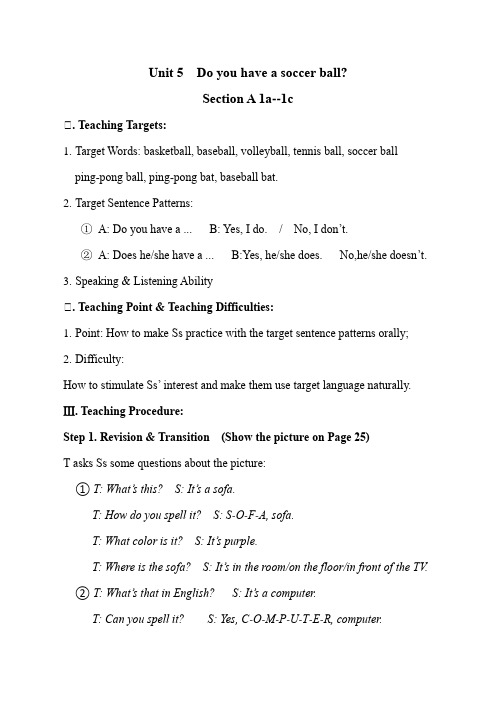
Unit 5 Do you have a soccer ball?Section A 1a--1cⅠ. Teaching Targets:1.Target Words: basketball, baseball, volleyball, tennis ball, soccer ballping-pong ball, ping-pong bat, baseball bat.2.Target Sentence Patterns:①A: Do you have a ... B: Yes, I do. / No, I don’t.②A: Does he/she have a ... B:Yes, he/she does. No,he/she doesn’t.3.Speaking & Listening AbilityⅠ. Teaching Point & Teaching Difficulties:1.Point: How to make Ss practice with the target sentence patterns orally;2.Difficulty:How to stimulate Ss’ interest and make them use target language naturally.Ⅲ. Teaching Procedure:Step 1. Revision & Transition (Show the picture on Page 25)T asks Ss some questions about the picture:①T: What’s this? S: It’s a sofa.T: How do you spell it? S: S-O-F-A, sofa.T: What color is it? S: It’s purple.T: Where is the sofa? S: It’s in the room/on the floor/in front of the TV.②T: What’s that in English? S: It’s a computer.T: Can you spell it? S: Yes, C-O-M-P-U-T-E-R, computer.T: Is it on the sofa? S: No, it isn’t. It’s on the desk.(设计意图:让学生复习之前学过的句型,自然过渡到新单元)T:OK, in this picture, we can also see some balls. That’s what we will learn in this unit. (板书标题和关键词)Step 2. Presentation of Words:1.Show Ss some pictures of balls(将图片用磁贴贴在黑板上), and make Ss repeat after T. (一一将单词写在相应图片下,并强调在拼写上左边三个是合在一起的,右边三个是分开的,bat是带网的球拍,racket是不带网的。
- 1、下载文档前请自行甄别文档内容的完整性,平台不提供额外的编辑、内容补充、找答案等附加服务。
- 2、"仅部分预览"的文档,不可在线预览部分如存在完整性等问题,可反馈申请退款(可完整预览的文档不适用该条件!)。
- 3、如文档侵犯您的权益,请联系客服反馈,我们会尽快为您处理(人工客服工作时间:9:00-18:30)。
池河中学2017-2018学年度第一学期教学设计
年级七
年
级
科目英语任课教师张坤翠授课时间
10.1
8
课题Unit5SectionA(1a-1c)授课类型听说
课标依据1.学生在对话交流中做到语音、语调基本正确、自然流畅。
2.学生能够熟根据读音规则拼读单词;理解和领悟所学词语的基本含义以及在特定语境中的意义并正确使用。
3.能够使用方位介词描述物品位置。
4.能听懂询问物品位置的对话,并从中提取信息。
教学目标知识与
技能
教学内容:
单词:
1.房间里的物品词汇:
table, bed, bookcase, sofa, chair
2.方位介词:in, on, under
句型:
Where is my…?
It’s in/on/under your….
编号:32
Where are my…?
技能目标:
通过本节课的学习学生能够
1.认读本节课的重点单词。
2.运用疑问词where引导的疑问句问答物品位置。
过程与方法过通过情景导读,ppt图片展示,进行看听学说等一系列师--生、生--生交流活动引导学生感知、体验、理解、运用核心词汇和目标句型。
(2)利用1a--1c任务驱动使学生进一步巩固掌握核心词汇和目标句型。
情感态度与价值观1.积极参与与学习活动。
2.关注并接受异国文化差异。
3.养成爱整洁、合理摆放物品的好习惯。
教学重点难点教学
重点
单词:table,bed, bookcase, sofa, chair
句型:
--Where is/are + the +物品?
-- It is/They are+ in/on/under the ..
教学
难点
Where is the…?Where are …?的正确运用。
教学师生活动设计意图
过程
设计
Step1 Warm-up and revision
1).Greetings。
2)Duty report
3).Show some pictures then ask: What’s
this ? .
(通过问答复习已学过的学习生活相关物品)
Step2 Presentation
1.To teach some furniture vocabulary by
showing pictures on the screen.
2.Finish the task in 1a.
Step3 Presentation.
Teach and learn “where”sentence pattern
by asking and answering.
Practice “Where” dialogue in groups and
pairs.
L
Step4.Listening in 1b
Discuss the picture in 1a.
While listening:To listen and finish the task.
Check the answers.
Step5.Task in 1c 1.通过图片复习学过的学习用品和学习新单词,让学生在当中去使用语言,激发学生学英语的积极性
2实物或图片教学单词帮助生迅速建立起目标词的读音与实物和词义之间的联系,减少心译过程,提高学习效率。
3.通过1a任务驱动巩固目标词汇。
4.在具体语境中感知、体验、
(学生两人一组进行对话,从模仿到操练,再尝试着编出新的对话.)
Step6 Summary and practice
Step8 Homework.
1.第一二梯队与同伴一起熟读并背诵1a中对话,然后编一组新对话写在作业本上.
第三梯队熟读,然后抄写并翻译1a对话。
2.与同桌一起练习1b 中的对话,然后问候自己的同学(四人小组互助)
3.完成绩优学案第一课时基础练习(全体做)理解、目标词汇和核心句型.
5.以听力训练和两两对话方式让学生认知1a中呈现的核心词汇和目标句型,促使学生听说读写技能全面、协调发展,达到整理语言,提升语言的准确性和思维逻辑的。
6.课后延展作业,巩固新知,为后续的进一步拓展学习奠定基础。
